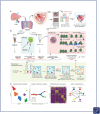Unraveling the Complexity of Liver Disease One Cell at a Time
- PMID: 36008091
- PMCID: PMC9451948
- DOI: 10.1055/s-0042-1755272
Unraveling the Complexity of Liver Disease One Cell at a Time
Abstract
The human liver is a complex organ made up of multiple specialized cell types that carry out key physiological functions. An incomplete understanding of liver biology limits our ability to develop therapeutics to prevent chronic liver diseases, liver cancers, and death as a result of organ failure. Recently, single-cell modalities have expanded our understanding of the cellular phenotypic heterogeneity and intercellular cross-talk in liver health and disease. This review summarizes these findings and looks forward to highlighting new avenues for the application of single-cell genomics to unravel unknown pathogenic pathways and disease mechanisms for the development of new therapeutics targeting liver pathology. As these technologies mature, their integration into clinical data analysis will aid in patient stratification and in developing treatment plans for patients suffering from liver disease.
Thieme. All rights reserved.
Conflict of interest statement
None declared.
Figures



Similar articles
-
Liver in infections: a single-cell and spatial transcriptomics perspective.J Biomed Sci. 2023 Jul 10;30(1):53. doi: 10.1186/s12929-023-00945-z. J Biomed Sci. 2023. PMID: 37430371 Free PMC article. Review.
-
Advances on liver cell-derived exosomes in liver diseases.J Cell Mol Med. 2021 Jan;25(1):15-26. doi: 10.1111/jcmm.16123. Epub 2020 Nov 27. J Cell Mol Med. 2021. PMID: 33247543 Free PMC article. Review.
-
Cooperation of liver cells in health and disease.Adv Anat Embryol Cell Biol. 2001;161:III-XIII, 1-151. doi: 10.1007/978-3-642-56553-3. Adv Anat Embryol Cell Biol. 2001. PMID: 11729749 Review.
-
Molecular therapeutics of liver disease.Clin Liver Dis. 2001 May;5(2):381-414, vi. doi: 10.1016/s1089-3261(05)70171-9. Clin Liver Dis. 2001. PMID: 11385969 Review.
-
Exosomes in chronic liver disease.Clin Chim Acta. 2023 Feb 1;540:117215. doi: 10.1016/j.cca.2022.117215. Epub 2023 Jan 2. Clin Chim Acta. 2023. PMID: 36603656 Review.
Cited by
-
RNA-based diagnostic innovations: A new frontier in diabetes diagnosis and management.Diab Vasc Dis Res. 2025 Mar-Apr;22(2):14791641251334726. doi: 10.1177/14791641251334726. Epub 2025 Apr 14. Diab Vasc Dis Res. 2025. PMID: 40230050 Free PMC article. Review.
-
Liver in infections: a single-cell and spatial transcriptomics perspective.J Biomed Sci. 2023 Jul 10;30(1):53. doi: 10.1186/s12929-023-00945-z. J Biomed Sci. 2023. PMID: 37430371 Free PMC article. Review.
References
-
- Ben-Moshe S, Itzkovitz S. Spatial heterogeneity in the mammalian liver. Nat Rev Gastroenterol Hepatol. 2019;16(07):395–410. - PubMed
Publication types
MeSH terms
Grants and funding
LinkOut - more resources
Full Text Sources
Medical
Research Materials

